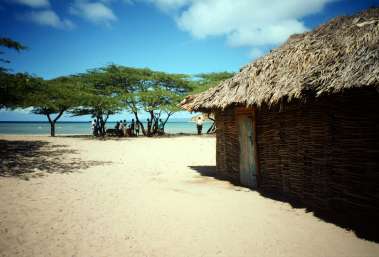| Everyday Life | Land and Agriculture | Transportation | The Hope | Resources |
 |
Hills of Ayiti
Women and donkeys walk endlessly from Baie des Moustiques to Port-de-Paix, hauling bundles of corn and plantains. The silent choreography of people and animals covers every corner of Haiti, from these once forested hills seen by Columbus, now thick with thornbush, down to saline mud flats. With no obvious presence of government, life here has an organization of its own.
 |
February is the dry season, and the Nord'ouest the driest area of Haiti. Jack straddles our jeep above foot-deep gullies which track the struggles of less fortunate travelers. "Bad" doesn't begin to describe the roads, which turn even the simplest journey into an epic of blowouts and breakdowns, hampering efforts at technical assistance. The night before we had to push our jeep up several hills, tire smoke and 4-inch rocks flying about our ankles. A light sprinkling of rain had turned the coating of road dust into a lubricant. Even my feet kept slipping out from me as I pushed against the bumper.
The first full day had been consumed by crossing the 140 miles from Port-au-Prince to Port-de-Paix, but by nightfall we had a chance to meet with some 60 farmers of Haut Moustique. Everybody was very excited to see us, as we crowded around the headlights trying to locate who was in charge with a key to the fenced meeting place. The meeting went very well, under a tin roofed pole hut, as we took turns explaining how we had come to listen, how we had some ideas about the problems of erosion and food for animals. I distributed seed of Argentine bahiagrass to one man, and through my bilingual companions, explained how it would need to be cared for, "plant it just before the summer rains."
 |
What I saw of the Northwest, especially from Bassin Bleu to Port-de-Paix and the six communities we visited, is in far better condition than I had imagined. People seem to have their own houses, neighbors they can count on, and a family structure. In a good year, life must be good in the Northwest. I did not see homelessness and poor health conditions in rural areas. Education received strong emphasis, as wherever we went at certain times of day there were large crowds of children in matching uniforms walking to school.
However, the lack of infrastructure puts the Northwest on brink of calamity because of little resource margin against natural disaster such as floods and droughts, and risks from tropical diseases.
The health clinics lack the basic requirements such as electricity to refrigerate medicines or the facilities to do anything other than serve as sick wards. I did see a very small wind generator at Baie de Moustiques, but do not know if it was operable.
Otherwise it appears that virtually all of Haiti other than Port-au-Prince and parts of large cities such as Port-de-Paix is without centralized electrical generation, without centralized water treatment and distribution, and without telephones. The abominable conditions of the road system would make any organized relief efforts very difficult.
Despite the Haitian reverence for the land, the trees, and the animals, population pressure is putting increasing demand on the natural resources.